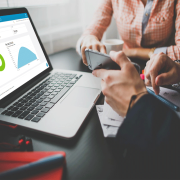Good enough isn’t going to give you a competitive advantage or allow you to adapt and grow. If you’re in distribution and you’re depending on good enough information systems in the fully digitized economy of today, the competitive advantage belongs to, well, your competition. Or your competition could arise from parts unknown- such as when your suppliers contract with low-cost distributors operating in the less developed parts of the world. Or, because of technological advancement they themselves might be leveraging, maybe for the first time they’re considering bypassing you and selling direct.

Most wholesalers initially built their businesses on entry-level accounting applications and later bolted-on multiple disparate applications. For years, it worked and, hey, if it isn’t broke (you know the rest). But that adage had a shelf life in an age where tested proven systems, tools and technologies have given certain nimble operators in distribution a huge advantage over competitors who were too slow to make the necessary adjustments and changes.
Archaic Processes Cost You Money
It’s undeniable that these entry-level applications and older legacy ERP systems are difficult to connect to modern business applications, usually resulting in costly customizations (been there?) or a hasty purchase of some complex and expensive warehouse management system. In addition to increased cost, customizations can potentially code-lock your information systems, preventing you from upgrading to newer versions that likely could have solved select bottlenecks or other workflow issues. You might be familiar with the fallout from this:
- Delayed customer Shipments
- Increased carrying costs
- Necessitate rush orders
- Partially filled orders
- Expired or obsolete inventory
- Inefficient returns management
5 Steps to Create Your Modernization Plan
To modernize your distribution and warehouse operations, first and foremost, you’ll need a plan. The systems and technologies that will allow you to remain razor-sharp competitive have existed for some time now…you’re not the guinea pig. You’ll need to come to a complete understanding of where you are now (systems, technology), diligently do your homework on your options, determine if (or when) to invest time and money, put together the plan and then execute that plan.

Here are the 5 steps:
- Foundation – Does your current platform and architecture allow you to connect to modern distribution and warehouse applications and technologies? Could simply upgrading your existing systems be adequate or has the time come to explore other options, specifically ERP applications built for the distribution industry.
- Research – Fully document and understand what your current system does and is capable of. Specifically identify the functional gaps your technology doesn’t address. Contact trusted partners and inquire about their prospective solutions.
- Prioritize– Using the identified functional gaps, construct a cost/benefit assessment of: 1.) not making any changes or 2.) a partial or wholesale upgrade. Start small and stick with high priority items and activities.
- Plan – Carefully and clearly define the goal and expected results. Identify the requisite technologies. Put in place a workable process and a realistic timeline. Include a contingency plan.
- Execution – Employ a phased-in approach. Make certain the project is broken down into smaller, achievable pieces. Once you go live, your users will need time to adapt to new processes. Engage and elicit feedback continuously. Expect the unexpected. Document everything.
In our digitized economy, growing distributors that use entry-level accounting or legacy ERP systems will need to modernize to remain competitive. Distributors will be required to respond to evolving industry pressures and customer needs. Modern ERP applications for distribution have proven themselves and are an operational lifeblood for many organizations that have already decided not to “see how this all plays out”. The net of all of this is when systems work exceptionally well, orders promptly get filled and customers stay happy.

Parallel Solutions has been helping distribution organizations since 1995 – including many ERP rollouts. We are uniquely positioned to guide you in transforming and modernizing your distribution operations. Have a question for our distribution experts? Call us at 440-498-9920 or email us at sales@parallelsolutions4u.com.



